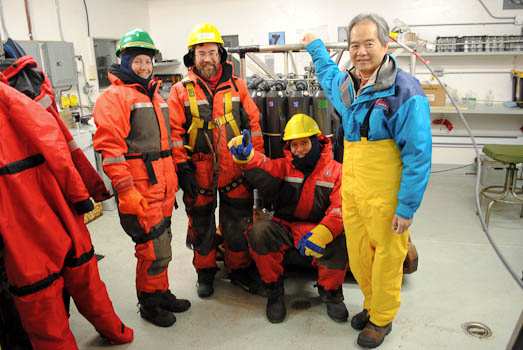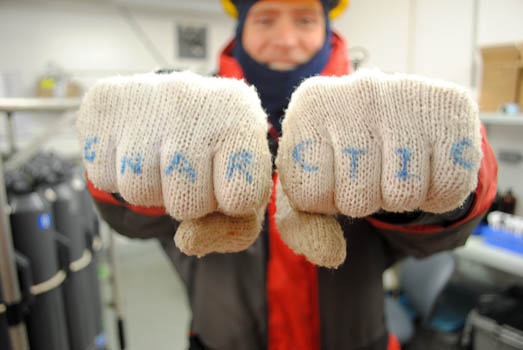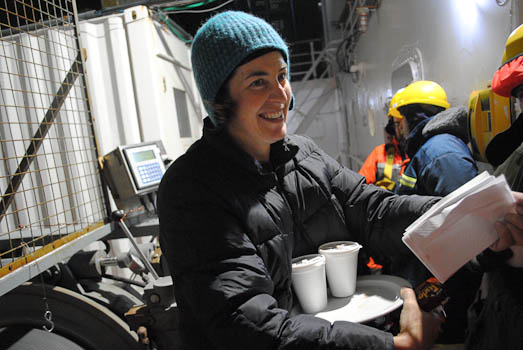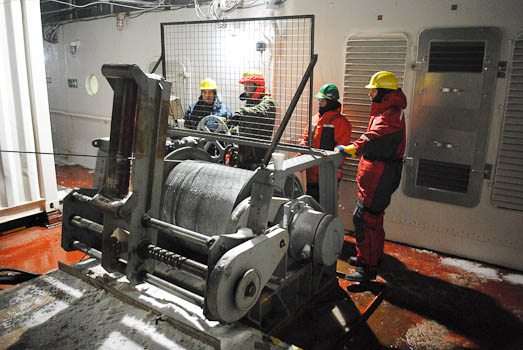Alex KainOctober 5, 2009
When the sun sets beneath the polar horizon, most people aboard the CCGS Louis S. St.-Laurent head to their rooms, insert earplugs, snuggle into bed, and fall asleep. But for a handful of scientists, the setting sun marks only the day's beginning. These night owls of the Arctic go by the group name "Night Watch." They ensure that science can be done when the ship passes sites of interest in the wee hours of the night. The job is a solitary one. Among a team of thirty researchers, only four are stationed on permanent Night Watch. What they lack in numbers they make up for in efficiency. They run rosette casts, enter data into spreadsheets, deploy bongo nets, and run bacteria samples when most scientists on board are well into their second REM cycles. Given the small size of the team, the ideal night crew is composed of scientists with experience on Arctic research vessels, and who have the stamina to survive an entire night outside in subzero temperatures. But if you ask them, their reason for their selection was personal, not professional. "We don't play well with large groups of people," jokes Mike Dempsey, a night watcher from Fisheries and Oceans Canada (DFO). Every evening, Chief Scientist Sarah Zimmermann meets with ship Captain Andrew McNeill to organize a schedule for the night watchers based on a preexisting deployment plan and requests from other scientists. Zimmermann then coordinates with colleagues from DFO to ensure that the scheduled deployments and tests are carried out.
Acclimation to a nocturnal lifestyle requires a bit of adjustment. "The transition required sleepless days, and a few times when it was difficult to make it through the night," says Jeff Charters, a night watcher from DFO. But after a few bleary-eyed afternoons, his circadian rhythms realigned to make him a bona fide night owl. For Charters, the most difficult part of adjusting to a nocturnal schedule was learning to sleep in an atmosphere where the sun shines, people socialize, and activities take place on deck. Deployments and recoveries that occur during the day produce considerable noise, especially when using bubblers, huge air compressors that blow air from the side of the ship to push away ice. Charters, whose room happens to be next to the bubblers, compares the noise to "a jet engine during takeoff." Anticipating an eventual readjustment at the end of the expedition, night watcher Kelly Young of DFO predicts that upon returning home to Victoria, BC, she will sleep for two days straight before returning to a diurnal schedule. Though difficult at times, being on the Night Watch also comes with its perks. When the cloud cover recedes, stars blanket the sky and the brushstrokes of the Northern Lights glow over a sea of twinkling ice. When the team's work is finished and they've earned a break, night watchers have the entire lounge to themselves to watch movies until the sun rises and they can go to the mess for a hearty breakfast.
Night watchers sometimes find the solitude of the night to be a productive working atmosphere. DFO's Edmand Fok considers his job of monitoring CTD casts easier at night because the environment presents fewer distractions. Dempsey, however, who spends more time on deck managing the hardware required for deployment, thinks the darkness and nighttime exhaustion make night watch physical labor significantly more challenging. The shared experience in the dark and cold fosters camaraderie in the team. Night watchers drink hot chocolate together and form inside jokes that only they understand. "It's one of those jobs that would be awful on your own, but with a few people it's bearable," says Charters.
The late nights occasionally inspire delirium and a fondness for the sunny hours of the day. "We have an idea for a 'Daywatch' calendar," says Charters. "The models would be wearing Mustang suits and running across the helicopter hangar in slow motion." For the time being, this night watcher's hope of a calendar will remain dream, a dream constructed at a time when most everyone else is in bed, dreaming as well. All text and photos property of Alex Kain. Last updated: October 7, 2019 | |||||||||||||||||||
Copyright ©2007 Woods Hole Oceanographic Institution, All Rights Reserved, Privacy Policy. | |||||||||||||||||||






